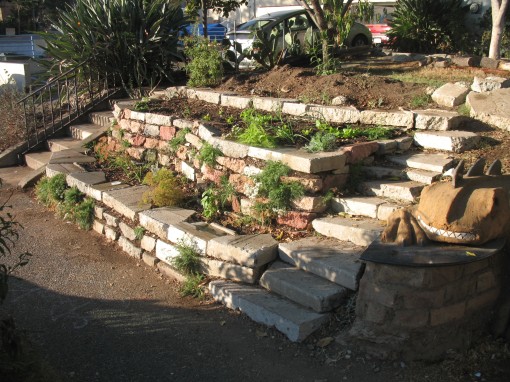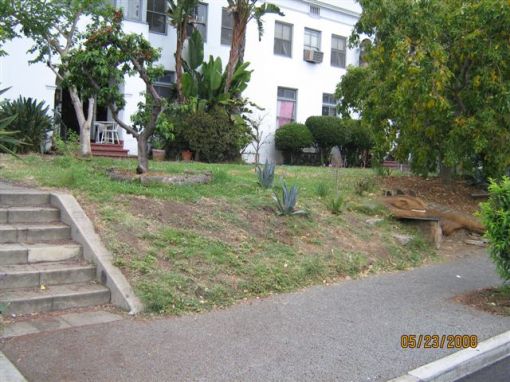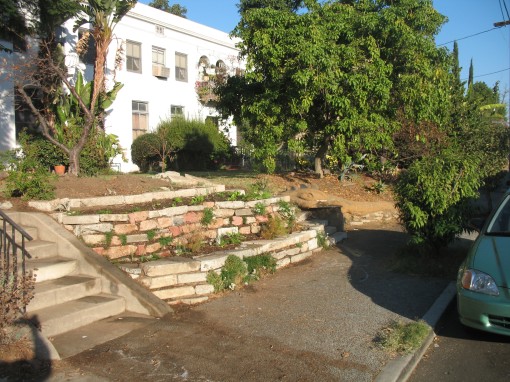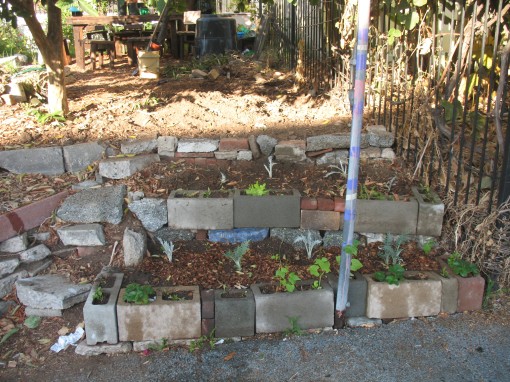
Las Trincheras - Passive Rainwater Harvesting Terraces at Los Angeles Eco-Village
Like a proud parent, I want to show off pictures of “Las Trincheras” – the stepped terraces that harvest rainwater in my front yard. These are inspired by Brad Lancaster, the water harvestologist from Tucson Arizona, whose books include excellent instructions for creating simple gravity-fed earthworks that detain and infiltrate rainwater.
I live at Los Angeles Eco-Village – an intentional community located in Koreatown in Los Angeles. The first terraces were begun as part of a hands-on urban permaculture course I taught here in the summer of 2008.

Sloped Grassy Area prior to Building Las Trincheras
Here’s a photo of what the area looked like in early June 2008. The sloped grassy surface ushered water off onto the sidewalk, and into the street. From there the water heads through a storm drain and into Ballona Creek and the Santa Monica Bay. We decided that we’d rather slow down these raindrops, and invite them to soak into the ground, where they can help sustain plants and trees. On a small scale, This prevents flooding and pollution and augments local groundwater supplies. Indirectly, to the extent that it can offset use of imported water that is pumped here at great cost, it also saves energy which helps curb global warming, resource wars, and more.
The first step was to weed the site as thoroughly as possible. This takes a lot of time, but if you don’t do it you’ll get a lot of hard-to-pull weeds growing up throughout your terraces.
Also prior to the worshop I obtained a stash of broken concrete, which we call “urbanite.” I had been gathering this from various construction projects I would bike past in my neighborhood, but, for this larger project, I did recruit a truck to get larger quantities. Most crews will have to pay to dispose this stuff, so they’ll give it to you for free, if you’ll take it off their hands. If they don’t want to give it to you, try coming by their site at a little after 5pm and you should be able to harvest it. I’ve found that the most useful pieces are those at least larger than a brick.
In addition to the urbanite, we arranged for a truckload of chipped tree-trimmings to use as mulch. This is another resource that’s generally available for free, as tree-trimmers will pay to dispose of it. They’ll ususally drop it off, but our contacts will only drop off full truck loads. We have them dump it in the street, then we haul it off and use it for mulching paths, courtyards, etc.

Las Trincheras at the End of the Water Harvesting Workshop (with lots of mulch piled on)
This photo shows the extent of the project completed at the ten-person workshop – it takes a while to weed and to set each level, so after a 1-day workshop (about half of which was actual building work), all we’d finished was one low terrace – as well as the stairs on the right. Thanks to my friend/neighbor and co-workshop leader Federico who took charge of constructing the stairs. You might notice that the stairs drain slightly to the left, into the beds and away from the cob lizard bench.
As Lancaster’s book tells, one important component for successful rainwater harvesting is to keep these retaining walls level – the terrace follows the contour of the landscape. Level terraces spread water out laterally along the contour, instead of allowing it to run off downhill. Use a level (tool) to make sure – a nice 6′ foot level is best, but you can make do with smaller. The sidewalk at the bottom of the photo (actually permeable pavement from a city of Los Angeles pedestrianization project) is sloped to the left. The top of the terrace wall is level. The wall serves multiple purposes (permaculture principles call this “stacking functions”) – it serves as a retaining wall for the garden bed and is also just the right height for sitting on, so it also serves as a bench. I am happy to say that it sees plenty of use, especially during class breaks at the adult school at the end of the block.

Las Trincheras this week
Here’s another picture of the trincheras today.
One mistake that I made in building them was to add too much mulch to to the soil. It’s definitely very good to mulch on top of the soil – especially after young plants have become established. Mulch itself is a water harvesting feature – it acts like a kind of one-way valve for water. The water soaks into the soil through the mulch, but the mulch shades the soil which blocks the sun from drying it out. It’s difficult to get seeds to start in mulched areas (which is another good thing about mulch – it prevents weeds from getting started.) I wanted to get more organic matter into the soil, so we added compost – which is a great amendment, but we also added mulch into the soil. Don’t try this at home. As chunks of wood break down in the soil, the process fixes some nutrients. This makes some of the soil nutrients less available to plants. When I planted corn and beans, immediately after building the terraces, the plants turned a relatively pale yellowish green and their growth was stunted. I gave them compost tea and they yielded some, but, still, overall, they didn’t do as well as I expected. Over time, the wood does break down and releases the nutrients back into the soil. While doing all this, the bed actually grows quite a bit of mushrooms… perhaps I should have taken advantage of this and planted good edible fungi?
Just lately we’ve had some of our first significant rains, and the greens, chard, strawberries, onions, mizuna, arrugula, and artichokes I’ve planted there seem to be fairly well. The morning after recent rains, the terraces were very much saturated with rainwater they’d absorbed.

The Other Newer Trincheras made of Cinder Blocks
I also created this second group of terraces a couple weeks ago. I didn’t have enough broken concrete, so I used some cinder blocks that were lying around unused. I filled the blocks with soil and planted in them. I am hoping that the plants grow out nicely and soften the somewhat linear gray lines of the blocks.
If LA Eco-Village garden readers are interested in reading more about about water harvesting and other local water issues (with an emphasis on river restoration and revitalization) you may want to check out the L.A. Creek Freak Blog, where I’ve cross posted this.